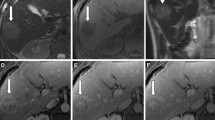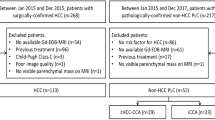Abstract
Objectives
To investigate the diagnostic accuracy of each LR-M feature defined in version 2017 of the Liver Imaging Reporting and Data System (LI-RADS) and determine the optimal LR-M feature for differentiating combined hepatocellular-cholangiocarcinoma (cHCC-CCA) and hepatocellular carcinoma (HCC) on gadoxetate-enhanced magnetic resonance imaging (MRI).
Methods
Ninety-nine patients with pathologically proven cHCC-CCA (n = 33) or HCC (n = 66) after surgery were identified. Two radiologists retrospectively assessed preoperative gadoxetate-enhanced MRI for features favoring non-HCC malignancies (LR-M features) according to LI-RADS version 2017. Multivariate logistic regression analysis was performed to determine the independent differential features. The sensitivity and specificity for diagnosing cHCC-CCA were calculated for each LR-M feature.
Results
Targetoid appearance showed the highest sensitivity (75.8%, 95% confidence interval [CI] 60.6%, 87.3%) to correctly identify cHCC-CCA as LR-M. At least one LR-M feature was observed in 31 (93.9%) patients with cHCC-CCA and 34 (51.5%) patients with HCC. The sensitivity and specificity for diagnosing cHCC-CCA using the presence of any one of the LR-M features were 93.9% (95% CI 80.7, 98.9) and 48.5% (95% CI 41.9, 51.0), respectively. The presence of three LR-M features yielded the highest diagnostic accuracy of 80.8% (95% CI 72.1, 86.1) with a reduced sensitivity of 54.5% (95% CI 41.4, 62.5).
Conclusion
The majority of cHCC-CCA cases can be properly categorized as LR-M when any one of the LR-M features defined in the LI-RADS version 2017 is used as a determiner. However, approximately half of HCC cases also show at least one LR-M feature.
Key Points
• Targetoid appearance, including rim APHE, peripheral “washout” appearance, and delayed central enhancement, was the LR-M feature that identified cHCC-CCA as a non-HCC malignancy with the highest sensitivity.
• Most cHCC-CCA cases can be properly categorized as LR-M when the presence of any one of the LR-M features was used as the determiner.
• Approximately half of HCC cases also showed at least one LR-M feature.




Similar content being viewed by others
Abbreviations
- APHE:
-
Arterial phase hyperenhancement
- cHCC-CCA:
-
Combined hepatocellular-cholangiocarcinoma
- DW:
-
Diffusion-weighted
- HBP:
-
Hepatobiliary phase
- HCC:
-
Hepatocellular carcinoma
- LI-RADS v2017:
-
Liver Imaging Reporting and Data System version 2017
- LR-M:
-
Tumors with imaging features of malignancy that are not specific for HCC
- MRI:
-
Magnetic resonance imaging
- TE:
-
Echo time
- TR:
-
Repetition time
References
Brunt E, Aishima S, Clavien PA et al (2018) cHCC-CCA: consensus terminology for primary liver carcinomas with both hepatocytic and cholangiocytic differentation. Hepatology 68:113–126
Yoon YI, Hwang S, Lee YJ et al (2016) Postresection outcomes of combined hepatocellular carcinoma-cholangiocarcinoma, hepatocellular carcinoma and intrahepatic cholangiocarcinoma. J Gastrointest Surg 20:411–420
Yin X, Zhang BH, Qiu SJ et al (2012) Combined hepatocellular carcinoma and cholangiocarcinoma: clinical features, treatment modalities, and prognosis. Ann Surg Oncol 19:2869–2876
Magistri P, Tarantino G, Serra V, Guidetti C, Ballarin R, Di Benedetto F (2017) Liver transplantation and combined hepatocellular-cholangiocarcinoma: feasibility and outcomes. Dig Liver Dis 49:467–470
Vilchez V, Shah MB, Daily MF et al (2016) Long-term outcome of patients undergoing liver transplantation for mixed hepatocellular carcinoma and cholangiocarcinoma: an analysis of the UNOS database. HPB (Oxford) 18:29–34
European Association for the Study of the Liver (2018) EASL clinical practice guidelines: management of hepatocellular carcinoma. J Hepatol 69:182–236
Heimbach JK, Kulik LM, Finn RS et al (2018) AASLD guidelines for the treatment of hepatocellular carcinoma. Hepatology 67:358–380
Fowler KJ, Sheybani A, Parker RA 3rd et al (2013) Combined hepatocellular and cholangiocarcinoma (biphenotypic) tumors: imaging features and diagnostic accuracy of contrast-enhanced CT and MRI. AJR Am J Roentgenol 201:332–339
Fraum TJ, Tsai R, Rohe E et al (2018) Differentiation of hepatocellular carcinoma from other hepatic malignancies in patients at risk: diagnostic performance of the Liver Imaging Reporting and Data System version 2014. Radiology 286:158–172
Mao Y, Xu S, Hu W et al (2017) Imaging features predict prognosis of patients with combined hepatocellular-cholangiocarcinoma. Clin Radiol 72:129–135
Park SH, Lee SS, Yu E et al (2017) Combined hepatocellular-cholangiocarcinoma: gadoxetic acid-enhanced MRI findings correlated with pathologic features and prognosis. J Magn Reson Imaging 46:267–280
Sheng RF, Xie YH, Ji Y et al (2016) MR comparative study of combined hepatocellular-cholangiocarcinoma in normal, fibrotic, and cirrhotic livers. Abdom Radiol (NY) 41:2102–2114
Maximin S, Ganeshan DM, Shanbhogue AK et al (2014) Current update on combined hepatocellular-cholangiocarcinoma. Eur J Radiol Open 1:40–48
Shetty AS, Fowler KJ, Brunt EM, Agarwal S, Narra VR, Menias CO (2014) Combined hepatocellular-cholangiocarcinoma: what the radiologist needs to know about biphenotypic liver carcinoma. Abdom Imaging 39:310–322
de Campos RO, Semelka RC, Azevedo RM et al (2012) Combined hepatocellular carcinoma-cholangiocarcinoma: report of MR appearance in eleven patients. J Magn Reson Imaging 36:1139–1147
Hwang J, Kim YK, Park MJ et al (2012) Differentiating combined hepatocellular and cholangiocarcinoma from mass-forming intrahepatic cholangiocarcinoma using gadoxetic acid-enhanced MRI. J Magn Reson Imaging 36:881–889
Elsayes KM, Hooker JC, Agrons MM et al (2017) 2017 version of LI-RADS for CT and MR imaging: an update. Radiographics 37:1994–2017
Fowler KJ, Potretzke TA, Hope TA, Costa EA, Wilson SR (2018) LI-RADS M (LR-M): definite or probable malignancy, not specific for hepatocellular carcinoma. Abdom Radiol (NY) 43:149–157
Potretzke TA, Tan BR, Doyle MB, Brunt EM, Heiken JP, Fowler KJ (2016) Imaging features of biphenotypic primary liver carcinoma (hepatocholangiocarcinoma) and the potential to mimic hepatocellular carcinoma: LI-RADS analysis of CT and MRI features in 61 cases. AJR Am J Roentgenol 207:25–31
Jeon SK, Joo I, Lee DH et al (2018) Combined hepatocellular cholangiocarcinoma: LI-RADS v2017 categorisation for differential diagnosis and prognostication on gadoxetic acid-enhanced MR imaging. Eur Radiol. https://doi.org/10.1007/s00330-018-5605-x
Kim YY, An C, Kim S, Kim MJ (2018) Diagnostic accuracy of prospective application of the Liver Imaging Reporting and Data System (LI-RADS) in gadoxetate-enhanced MRI. Eur Radiol 28:2038–2046
(2018) CT/MRI LI-RADS® v2018. Available via https://www.acr.org/Clinical-Resources/Reporting-and-Data-Systems/LI-RADS/CT-MRI-LIRADSv2018. Accessed 8 Aug 2018
An C, Park S, Chung YE et al (2017) Curative resection of single primary hepatic malignancy: liver imaging reporting and data system category LR-M portends a worse prognosis. AJR Am J Roentgenol 209:576–583
Tang A, Bashir MR, Corwin MT et al (2018) Evidence supporting LI-RADS major features for CT- and MR imaging-based diagnosis of hepatocellular carcinoma: a systematic review. Radiology 286:29–48
Park HJ, Jang KM, Kang TW et al (2016) Identification of imaging predictors discriminating different primary liver tumours in patients with chronic liver disease on gadoxetic acid-enhanced MRI: a classification tree analysis. Eur Radiol 26:3102–3111
Park MJ, Kim YK, Park HJ, Hwang J, Lee WJ (2013) Scirrhous hepatocellular carcinoma on gadoxetic acid-enhanced magnetic resonance imaging and diffusion-weighted imaging: emphasis on the differentiation of intrahepatic cholangiocarcinoma. J Comput Assist Tomogr 37:872–881
Park HJ, Kim YK, Park MJ, Lee WJ (2013) Small intrahepatic mass-forming cholangiocarcinoma: target sign on diffusion-weighted imaging for differentiation from hepatocellular carcinoma. Abdom Imaging 38:793–801
Kang Y, Lee JM, Kim SH, Han JK, Choi BI (2012) Intrahepatic mass-forming cholangiocarcinoma: enhancement patterns on gadoxetic acid-enhanced MR images. Radiology 264:751–760
Li R, Yang D, Tang CL et al (2016) Combined hepatocellular carcinoma and cholangiocarcinoma (biphenotypic) tumors: clinical characteristics, imaging features of contrast-enhanced ultrasound and computed tomography. BMC Cancer 16:158
Horvat N, Nikolovski I, Long N et al (2018) Imaging features of hepatocellular carcinoma compared to intrahepatic cholangiocarcinoma and combined tumor on MRI using liver imaging and data system (LI-RADS) version 2014. Abdom Radiol (NY) 43:169–178
Funding
The authors state that this work has not received any funding.
Author information
Authors and Affiliations
Corresponding author
Ethics declarations
Guarantor
The scientific guarantor of this publication is Myeong-Jin Kim.
Conflict of interest
The authors of this manuscript declare no relationships with any companies, whose products or services may be related to the subject matter of the article.
Statistics and biometry
No complex statistical methods were necessary for this paper.
Informed consent
Written informed consent was waived by the Institutional Review Board.
Ethical approval
Institutional Review Board approval was obtained.
Methodology
• retrospective
• case-control study
• performed at one institution
Rights and permissions
About this article
Cite this article
Lee, H.S., Kim, MJ. & An, C. How to utilize LR-M features of the LI-RADS to improve the diagnosis of combined hepatocellular-cholangiocarcinoma on gadoxetate-enhanced MRI?. Eur Radiol 29, 2408–2416 (2019). https://doi.org/10.1007/s00330-018-5893-1
Received:
Revised:
Accepted:
Published:
Issue Date:
DOI: https://doi.org/10.1007/s00330-018-5893-1




